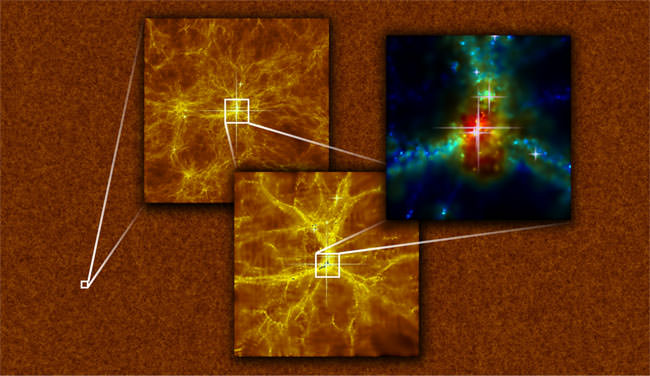[/caption]
What fed early black holes enabling their very rapid growth? A new discovery made by researchers at Carnegie Mellon University using a combination of supercomputer simulations and GigaPan Time Machine technology shows that a diet of cosmic “fast food” (thin streams of cold gas) flowed uncontrollably into the center of the first black holes, causing them to be “supersized” and grow faster than anything else in the Universe.
When our Universe was young, less than a billion years after the Big Bang, galaxies were just beginning to form and grow. According to prior theories, black holes at that time should have been equally small. Data from the Sloan Digital Sky Survey has shown evidence to the contrary – supermassive black holes were in existence as early as 700 million years after the Big Bang.
“The Sloan Digital Sky Survey found supermassive black holes at less than 1 billion years. They were the same size as today’s most massive black holes, which are 13.6 billion years old,” said Tiziana Di Matteo, associate professor of physics (Carnegie Mellon University). “It was a puzzle. Why do some black holes form so early when it takes the whole age of the Universe for others to reach the same mass?”
Supermassive black holes are the largest black holes in existence – weighing in with masses billions of times that of the Sun. Most “normal” black holes are only about 30 times more massive than the Sun. The currently accepted mechanism for the formation of supermassive black holes is through galactic mergers. One problem with this theory and how it applies to early supermassive black holes is that in early Universe, there weren’t many galaxies, and they were too distant from each other to merge.
Rupert Croft, associate professor of physics (Carnegie Mellon University) remarked, “If you write the equations for how galaxies and black holes form, it doesn’t seem possible that these huge masses could form that early, But we look to the sky and there they are.”
In an effort to understand the processes that formed the early supermassive black holes, Di Matteo, Croft and Khandai created MassiveBlack – the largest cosmological simulation to date. The purpose of MassiveBlack is to accurately simulate the first billion years of our universe. Describing MassiveBlack, Di Matteo remarked, “This simulation is truly gigantic. It’s the largest in terms of the level of physics and the actual volume. We did that because we were interested in looking at rare things in the universe, like the first black holes. Because they are so rare, you need to search over a large volume of space”.
Croft and the team started the simulations using known models of cosmology based on theories and laws of modern day physics. “We didn’t put anything crazy in. There’s no magic physics, no extra stuff. It’s the same physics that forms galaxies in simulations of the later universe,” said Croft. “But magically, these early quasars, just as had been observed, appear. We didn’t know they were going to show up. It was amazing to measure their masses and go ‘Wow! These are the exact right size and show up exactly at the right point in time.’ It’s a success story for the modern theory of cosmology.”
The data from MassiveBlack was added to the GigaPan Time Machine project. By combining the MassiveBlack data with the GigaPan Time Machine project, researchers were able to view the simulation as if it was a movie – easily panning across the simulated universe as it formed. When the team noticed events which appeared interesting, they were also able to zoom in to view the events in greater detail than what they could see in our own universe with ground or space-based telescopes.
When the team zoomed in on the creation of the first supermassive black holes, they saw something unexpected. Normal observations show that when cold gas flows toward a black hole it is heated from collisions with other nearby gas molecules, then cools down before entering the black hole. Known as ‘shock heating’, the process should have stopped early black holes from reaching the masses observed. Instead, the team observed thin streams of cold dense gas flowing along ‘filaments’ seen in large-scale surveys that reveal the structure of our universe. The filaments allowed the gas to flow directly into the center of the black holes at incredible speed, providing them with cold, fast food. The steady, but uncontrolled consumption provided a mechanism for the black holes to grow at a much faster rate than their host galaxies.
The findings will be published in the Astrophysical Journal Letters.
If you’d like to read more, check out the papers below ( via Physics arXiv ):
Terapixel Imaging of Cosmological Simulations
The Formation of Galaxies Hosting z~6 Quasars
Early Black Holes in Cosmological Simulations
Cold Flows and the First Quasars
Learn more about Gigapan and MassiveBlack at: http://gigapan.org/gigapans/76215/ and http://www.psc.edu/science/2011/supermassive/


